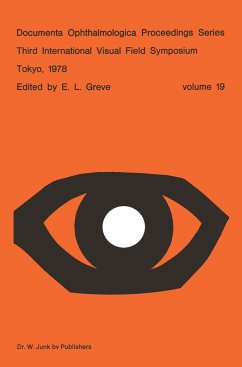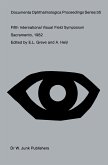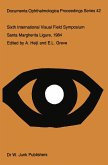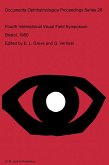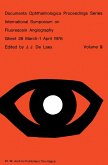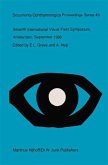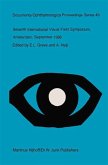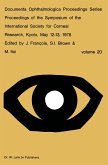E. L. Greve
Third International Visual Field Symposium Tokyo, May 3¿6, 1978
E. L. Greve
Third International Visual Field Symposium Tokyo, May 3¿6, 1978
- Broschiertes Buch
- Merkliste
- Auf die Merkliste
- Bewerten Bewerten
- Teilen
- Produkt teilen
- Produkterinnerung
- Produkterinnerung
ERIK L. GREVE The 3rd International Visual Field Symposium was held on the 4th till the 6th of May 1978 in Tokyo for the members and guests of the International Perimetric Society. The Proceedings of this symposium follow the general lines of the pro gramme with some minor alterations. This symposium was a so-called topic-symposium where selected topics were introduced by experts in the field. These topics were: Neuro-ophtha[mo[ogy. 1. Funduscopic correlates of visual field defects. 2. Visual field defects due to tumors of the sellar region. Glaucoma. 1. The earliest visual field defects in…mehr
Andere Kunden interessierten sich auch für
![Fifth International Visual Field Symposium Fifth International Visual Field Symposium]() Fifth International Visual Field Symposium41,99 €
Fifth International Visual Field Symposium41,99 €![Sixth International Visual Field Symposium Sixth International Visual Field Symposium]() Sixth International Visual Field Symposium41,99 €
Sixth International Visual Field Symposium41,99 €![Fourth International Visual Field Symposium Bristol, April 13¿16,1980 Fourth International Visual Field Symposium Bristol, April 13¿16,1980]() Fourth International Visual Field Symposium Bristol, April 13¿16,198041,99 €
Fourth International Visual Field Symposium Bristol, April 13¿16,198041,99 €![International Symposium on Fluorescein Angiography Ghent 28 March-1 April 1976 International Symposium on Fluorescein Angiography Ghent 28 March-1 April 1976]() International Symposium on Fluorescein Angiography Ghent 28 March-1 April 197642,99 €
International Symposium on Fluorescein Angiography Ghent 28 March-1 April 197642,99 €![Seventh International Visual Field Symposium, Amsterdam, September 1986 Seventh International Visual Field Symposium, Amsterdam, September 1986]() E.L. Greve / A. Heijl (eds.)Seventh International Visual Field Symposium, Amsterdam, September 1986243,99 €
E.L. Greve / A. Heijl (eds.)Seventh International Visual Field Symposium, Amsterdam, September 1986243,99 €![Seventh International Visual Field Symposium, Amsterdam, September 1986 Seventh International Visual Field Symposium, Amsterdam, September 1986]() Seventh International Visual Field Symposium, Amsterdam, September 1986242,99 €
Seventh International Visual Field Symposium, Amsterdam, September 1986242,99 €![Proceedings of the Symposium of the International Society for Corneal Research, Kyoto, May 12¿13, 1978 Proceedings of the Symposium of the International Society for Corneal Research, Kyoto, May 12¿13, 1978]() Proceedings of the Symposium of the International Society for Corneal Research, Kyoto, May 12¿13, 197841,99 €
Proceedings of the Symposium of the International Society for Corneal Research, Kyoto, May 12¿13, 197841,99 €-
-
-
ERIK L. GREVE The 3rd International Visual Field Symposium was held on the 4th till the 6th of May 1978 in Tokyo for the members and guests of the International Perimetric Society. The Proceedings of this symposium follow the general lines of the pro gramme with some minor alterations. This symposium was a so-called topic-symposium where selected topics were introduced by experts in the field. These topics were: Neuro-ophtha[mo[ogy. 1. Funduscopic correlates of visual field defects. 2. Visual field defects due to tumors of the sellar region. Glaucoma. 1. The earliest visual field defects in glaucoma. 2. The reversibility of glaucomatous visual field defects. Methodology. 1. Automation. 2. The relation between the position of a lesion in the fundus and in the visual field. Apart from the introductory papers, free papers were given on the topics non-topic free papers. and also some Much attention has been given to the discussion. Most of the discussion remarks in this Proceedings are the original taped remarks of the discussion speakers. We have choosen this form of presentation to take to the reader the athmosphere of the discussion and to preserve originality. The chairman of the sessions have presented a summary or even better an interpretation of the trends in their topics. This introduction gives a short overview of the main themes of the symposium.
Hinweis: Dieser Artikel kann nur an eine deutsche Lieferadresse ausgeliefert werden.
Hinweis: Dieser Artikel kann nur an eine deutsche Lieferadresse ausgeliefert werden.
Produktdetails
- Produktdetails
- Documenta Ophthalmologica Proceedings Series 19
- Verlag: Springer / Springer Netherlands
- Artikelnr. des Verlages: 978-90-6193-160-7
- Softcover reprint of the original 1st ed. 1979
- Seitenzahl: 500
- Erscheinungstermin: 31. März 1979
- Englisch
- Abmessung: 235mm x 155mm x 27mm
- Gewicht: 940g
- ISBN-13: 9789061931607
- ISBN-10: 9061931606
- Artikelnr.: 25643967
- Herstellerkennzeichnung Die Herstellerinformationen sind derzeit nicht verfügbar.
- Documenta Ophthalmologica Proceedings Series 19
- Verlag: Springer / Springer Netherlands
- Artikelnr. des Verlages: 978-90-6193-160-7
- Softcover reprint of the original 1st ed. 1979
- Seitenzahl: 500
- Erscheinungstermin: 31. März 1979
- Englisch
- Abmessung: 235mm x 155mm x 27mm
- Gewicht: 940g
- ISBN-13: 9789061931607
- ISBN-10: 9061931606
- Artikelnr.: 25643967
- Herstellerkennzeichnung Die Herstellerinformationen sind derzeit nicht verfügbar.
Session I. Neuro-ophthalmology.- Funduscopic correlates of visual field defects due to lesions of the anterior visual pathway.- Correlations between atrophy of maculopapillar bundles and visual functions in cases of optic neuropathies.- Visual field defects due to tumors of the sellar region.- Visual fields before and after transnasal removal of a pituitary tumor.- Visual field defects in anterior ischemic optic neuropathy.- Comparison of visual field defects in glaucoma and in acute anterior ischemic optic neuropathy.- Visual field defects due to hypoplasia of the optic nerve.- Visual field defects in congenital hydrocephalus.- Central critical fusion frequency in neuro-ophthalmological practice.- Discussion of the session on Neuro-ophthalmology.- Summary of session I: Neuro-ophthalmology.- Session II. Glaucoma.- Early glaucomatous visual field defects and their significance to clinical ophthalmology.- The early visual field defects in glaucoma and the significance of nasal steps.- A critical phase in the development of glaucomatous visual field defects.- Analysis of patients with open-angle glaucoma using perimetric techniques reflecting receptive field-like properties.- Liminal and supraliminal stimuli in the perimetry of chronic simple glaucoma.- Acquired dyschromatopsias the earliest functional losses in glaucoma.- The relation between depression in the Bjerrum area and nasal step in early glaucoma (DBA & NS).- Reversibility of glaucomatous defects of the visual field.- Visual field defects in open-angle glaucoma: progression and regression.- The clinical significance of reversibility of glaucomatous visual field defects.- Recovery of visual function during elevation of the infraocular pressure.- The mode of development and progression of field defects in early glaucoma - A follow-up study.- Peripheral nasal field defects in glaucoma.- Reversibility of visual field defects in simple glaucoma.- Reversible cupping and reversible field defect in glaucoma.- The reversibility of visual field defects in the juvenile glaucoma cases.- Early stage progression in glaucomatous visual field changes.- The earliest visual field defect (IIa Stage) in glaucoma by kinetic perimetry.- Relationship between IOP level and visual field in open-angle glaucoma (Study for critical pressure in glaucoma).- The relationship between visual field changes and intra-ocular pressure.- Visual field change examined by pupillography in glaucoma.- The nasal step: An early glaucomatous defect?.- Discussion of the session on Glaucoma.- Summary of Session II: Glaucoma.- Session III. Automation.- Threshold fluctuations, interpolations and spatial resolution in perimetry.- Semi-automatic campimeter with graphic display.- Automatic computerized perimetry in neuro-ophthalmology.- Automated perimetry: Minicomputers or microprocessors?.- Discussion of the session on Automation.- Summary of session III: Automation.- Session IV. Methodology.- Fundus controlled perimetry.- Experimental fundus photo perimeter and its application.- A simple fundus perimetry with fundus camera.- The influence of spontaneous eye-rotation on the perimetric determination of small scotomas.- Analysis of angioscotoma testing with Friedmann visual field analyser and Tübinger perimeter.- Comparative examinations of visual function and fluorescein angiography in early stages of senile disCiform macular degeneration.- The relationship between fundus lesions and areas of functional change.- Visual field changes after photocoagulation in retinal branch vein occlusion.- Visual field changes in mesopic andscotopic conditions using Friedmann visual field analyser.- Relationship between perimetric eccentricity and retinal locus in a human eye.- A new interpretation of the relative central scotoma for blue stimuli under photopic conditions.- Discussion of the session on Methodology.- Summary of session IV: Methodology.- Session V. Free Papers.- The enlargement of the blind spot in binocular vision.- Evaluation of perimetric procedures a statistical approch.- Eye movements during peripheral field tests monitored by electrooculogram.- Trial of a color perimeter.- Videopupillographic perimetry perimetric findings with rabbit eyes.- Clinical experiences with a new multiple dot plate.- Electroencephalographic perimetry clinical applications of vertex potentials elicited by focal retinal stimulation.- Relation between central and peripheral visual field changes with kinetic perimetry.- Discussion on the free papers session.- Report of the IPS research group on standards.- Report on colour perimetry.- Closing speech.- List of contributors.
Session I. Neuro-ophthalmology.- Funduscopic correlates of visual field defects due to lesions of the anterior visual pathway.- Correlations between atrophy of maculopapillar bundles and visual functions in cases of optic neuropathies.- Visual field defects due to tumors of the sellar region.- Visual fields before and after transnasal removal of a pituitary tumor.- Visual field defects in anterior ischemic optic neuropathy.- Comparison of visual field defects in glaucoma and in acute anterior ischemic optic neuropathy.- Visual field defects due to hypoplasia of the optic nerve.- Visual field defects in congenital hydrocephalus.- Central critical fusion frequency in neuro-ophthalmological practice.- Discussion of the session on Neuro-ophthalmology.- Summary of session I: Neuro-ophthalmology.- Session II. Glaucoma.- Early glaucomatous visual field defects and their significance to clinical ophthalmology.- The early visual field defects in glaucoma and the significance of nasal steps.- A critical phase in the development of glaucomatous visual field defects.- Analysis of patients with open-angle glaucoma using perimetric techniques reflecting receptive field-like properties.- Liminal and supraliminal stimuli in the perimetry of chronic simple glaucoma.- Acquired dyschromatopsias the earliest functional losses in glaucoma.- The relation between depression in the Bjerrum area and nasal step in early glaucoma (DBA & NS).- Reversibility of glaucomatous defects of the visual field.- Visual field defects in open-angle glaucoma: progression and regression.- The clinical significance of reversibility of glaucomatous visual field defects.- Recovery of visual function during elevation of the infraocular pressure.- The mode of development and progression of field defects in early glaucoma - A follow-up study.- Peripheral nasal field defects in glaucoma.- Reversibility of visual field defects in simple glaucoma.- Reversible cupping and reversible field defect in glaucoma.- The reversibility of visual field defects in the juvenile glaucoma cases.- Early stage progression in glaucomatous visual field changes.- The earliest visual field defect (IIa Stage) in glaucoma by kinetic perimetry.- Relationship between IOP level and visual field in open-angle glaucoma (Study for critical pressure in glaucoma).- The relationship between visual field changes and intra-ocular pressure.- Visual field change examined by pupillography in glaucoma.- The nasal step: An early glaucomatous defect?.- Discussion of the session on Glaucoma.- Summary of Session II: Glaucoma.- Session III. Automation.- Threshold fluctuations, interpolations and spatial resolution in perimetry.- Semi-automatic campimeter with graphic display.- Automatic computerized perimetry in neuro-ophthalmology.- Automated perimetry: Minicomputers or microprocessors?.- Discussion of the session on Automation.- Summary of session III: Automation.- Session IV. Methodology.- Fundus controlled perimetry.- Experimental fundus photo perimeter and its application.- A simple fundus perimetry with fundus camera.- The influence of spontaneous eye-rotation on the perimetric determination of small scotomas.- Analysis of angioscotoma testing with Friedmann visual field analyser and Tübinger perimeter.- Comparative examinations of visual function and fluorescein angiography in early stages of senile disCiform macular degeneration.- The relationship between fundus lesions and areas of functional change.- Visual field changes after photocoagulation in retinal branch vein occlusion.- Visual field changes in mesopic andscotopic conditions using Friedmann visual field analyser.- Relationship between perimetric eccentricity and retinal locus in a human eye.- A new interpretation of the relative central scotoma for blue stimuli under photopic conditions.- Discussion of the session on Methodology.- Summary of session IV: Methodology.- Session V. Free Papers.- The enlargement of the blind spot in binocular vision.- Evaluation of perimetric procedures a statistical approch.- Eye movements during peripheral field tests monitored by electrooculogram.- Trial of a color perimeter.- Videopupillographic perimetry perimetric findings with rabbit eyes.- Clinical experiences with a new multiple dot plate.- Electroencephalographic perimetry clinical applications of vertex potentials elicited by focal retinal stimulation.- Relation between central and peripheral visual field changes with kinetic perimetry.- Discussion on the free papers session.- Report of the IPS research group on standards.- Report on colour perimetry.- Closing speech.- List of contributors.

